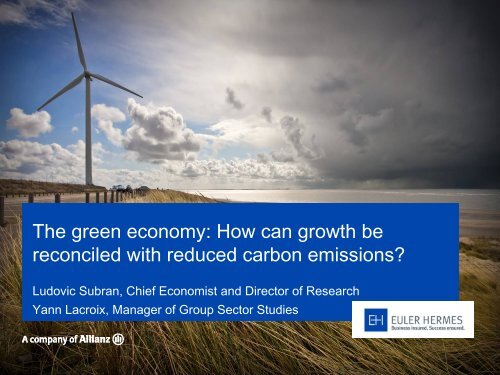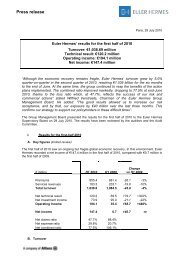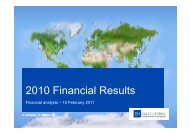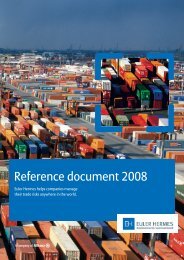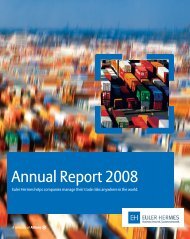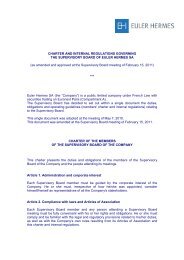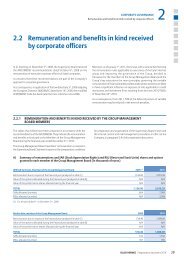Presentation Green Economy - Euler Hermes
Presentation Green Economy - Euler Hermes
Presentation Green Economy - Euler Hermes
Create successful ePaper yourself
Turn your PDF publications into a flip-book with our unique Google optimized e-Paper software.
The green economy: How can growth be<br />
reconciled with reduced carbon emissions?<br />
Ludovic Subran, Chief Economist and Director of Research<br />
Yann Lacroix, Manager of Group Sector Studies
Context<br />
Why this special dossier?<br />
� C02 emissions have been rising with population growth and wealth<br />
� At a time of world economic slowdown and intensified austerity measures, especially in Europe,<br />
commitment to promising sectoral dynamics is needed<br />
Underlying incentives of a three-way economical arbitrage<br />
� Cost constraints: already generating innovation (targeted profitability),<br />
additional costs are bearable if they are quickly recovered<br />
but hard to finance if the return on investment is slow<br />
� New markets: building international competitiveness and capturing new outlets seem possible<br />
� Role of incentives from the State: on the one hand, via international regulation by establishing<br />
payable carbon quotas and establishing a long-term partnership;<br />
and, on the on other hand, stimuli (financing, subsidies) that are hard at a time of budget cuts<br />
but which play a part in strategic development<br />
Two definitions<br />
� <strong>Green</strong> growth: economic growth with lower C02 emissions<br />
� <strong>Green</strong> economy: investment (additional activity) to achieve green growth<br />
Press Conference – 15 November 2011, Paris<br />
2
The green economy: How can growth be<br />
reconciled with reduced carbon emissions?<br />
1<br />
2<br />
3<br />
4<br />
A worrying acceleration in carbon emissions<br />
The development in alternative energy sources remains embryonic<br />
The green economy offers growth potential for some sectors<br />
Conclusion: seize the opportunities<br />
Press Conference – 15 November 2011, Paris<br />
3
Growing international awareness:<br />
Advances and impasses<br />
United Nations Framework Convention on Climate Change<br />
United Nations<br />
Framework<br />
Convention on<br />
Climate Change<br />
1992 1997 2003 2005 2008 2013 2020<br />
Signature of the<br />
Kyoto Protocol<br />
Press Conference – 15 November 2011, Paris<br />
EU directive creating<br />
the European Union<br />
Emission Trading<br />
System (EU ETS*)<br />
*EU ETS: Europe Union Emission Trading System<br />
Source: CITEPA<br />
Phase I of the EU<br />
ETS:<br />
01/01/2005 to<br />
31/12/2007<br />
First commitment period of<br />
the Kyoto Protocol<br />
(01/01/2008 to 31/12/2012):<br />
5.2% cut in greenhouse gas<br />
emissions from 1990 levels<br />
Phase II of the EU ETS:<br />
1/01/2008 to 31/12/2012<br />
The EU commits to an<br />
8% reduction in its<br />
carbon emissions<br />
Phase III of the EU ETS:<br />
01/01/2013 au 31/12/2020<br />
The ‘3x20’:<br />
> 20% cut in greenhouse gases<br />
> 20% cut in energy consumption<br />
> 20% of energy from renewable<br />
sources<br />
4
Carbon emissions: a disastrous combination of the<br />
effects of growth in both population and wealth<br />
Asia’s share of carbon emissions rose sharply between 2000 and 2009<br />
20.0<br />
18.0<br />
16.0<br />
14.0<br />
12.0<br />
10.0<br />
8.0<br />
6.0<br />
4.0<br />
2.0<br />
0.0<br />
Tonnes of CO2 emissions per capita, per year Change in emissions, weighted by change in population<br />
8.8<br />
-7.4%<br />
Source: BP statistics<br />
Press Conference – 15 November 2011, Paris<br />
19.0<br />
-13.7%<br />
2.8<br />
51.8%<br />
5.3<br />
5.7%<br />
Europe North America Asia Others<br />
Europe: France, Germany, Italy, Spain, UK, Poland and Russia<br />
North America: US and Canada<br />
Asia: Japan, China, Taiwan, India and Indonesia<br />
60.0%<br />
50.0%<br />
40.0%<br />
30.0%<br />
20.0%<br />
10.0%<br />
0.0%<br />
-10.0%<br />
-20.0%<br />
5
An impossible investment effort?<br />
To get carbon emissions back to 2010 levels by 2030, emissions will have to be cut<br />
by 1.5% a year starting in 2020 according to the Kyoto Protocol<br />
Gigatonnes<br />
Change in carbon emissions worldwide (in Gt)<br />
45<br />
40<br />
35<br />
30<br />
25<br />
20<br />
Source: IEA, OECD, <strong>Euler</strong> <strong>Hermes</strong><br />
Press Conference – 15 November 2011, Paris<br />
Impact of recession<br />
1990 1995 2000 2005 2010 2015 2020 2025 2030<br />
<strong>Euler</strong> <strong>Hermes</strong> forecast:<br />
due to massive<br />
population growth and<br />
delayed investment<br />
Best-case scenario:<br />
a cut of 1.5% in C02<br />
emissions per year<br />
To meet this target, the<br />
OECD expects the cost<br />
of investments to be<br />
around $750bn a year<br />
from now until 2030,<br />
and at $1.6tn a year<br />
thereafter<br />
6
The green economy: How can growth be<br />
reconciled with reduced carbon emissions?<br />
4<br />
1<br />
2<br />
3<br />
A worrying acceleration in carbon emissions<br />
The development in alternative energy sources remains embryonic<br />
The green economy offers growth potential first of all for some sectors<br />
Conclusion: seize the opportunities<br />
Press Conference – 15 November 2011, Paris<br />
7
Electricity production continues to be mostly from<br />
fossil fuels, and their relative share continues to grow<br />
Clean electricity generation has yet to be invented…<br />
1999<br />
Fossil<br />
63.5%<br />
Others<br />
1.4%<br />
Source: Oberv’ER<br />
Wind<br />
0.1%<br />
Press Conference – 15 November 2011, Paris<br />
Solar<br />
0.0%<br />
Hydro<br />
17.7%<br />
Nuclear<br />
17.2%<br />
2009 Wind<br />
Solar<br />
Others 1.3%<br />
0.2%<br />
1.7%<br />
Fossil<br />
67.1%<br />
Hydro<br />
16.1%<br />
Nuclear<br />
13.5%<br />
Some alternative energy sources offer opportunities for green growth…<br />
Pertinence: emissions from energy production account for 22% of total C02 emissions<br />
…however, the transformation of the productive apparatus seems to have<br />
stalled<br />
The relative share of hydro in world electricity generation has fallen in recent years. What about<br />
the others?<br />
8
Nuclear power: a source of electricity that has not<br />
risen for five years<br />
TWh<br />
World electricity output (in TWh) from nuclear power<br />
3 000<br />
2 500<br />
2 000<br />
1 500<br />
1 000<br />
500<br />
0<br />
Source: BP statistics<br />
Press Conference – 15 November 2011, Paris<br />
Europe North America Asia Others<br />
2003 2004 2005 2006 2007 2008 2009 2010<br />
In 2010, nuclear power<br />
accounted for 14% of world<br />
electricity production.<br />
In 2003, it accounted for 16%<br />
Use of nuclear power avoids<br />
carbon emissions totalling<br />
2.5 Gt a year (or around 9% of<br />
global emissions); however it<br />
creates collateral radioactive<br />
waste that needs to be stored<br />
over a very long timeframe<br />
The nuclear meltdown at<br />
Fukushima in Japan in March<br />
2011 might threaten the<br />
potential of nuclear power<br />
generation in Asia<br />
9
Wind power: a halt in investments in 2010<br />
A marked fall in new installations: -5% in Europe, -50% in North America<br />
TWh<br />
Yearly capacity installation (in TWh)<br />
45<br />
40<br />
35<br />
30<br />
25<br />
20<br />
15<br />
10<br />
5<br />
0<br />
Source: BP statistics<br />
Press Conference – 15 November 2011, Paris<br />
North America Europe Asia Others<br />
2003 2004 2005 2006 2007 2008 2009 2010<br />
In 2010 wind power<br />
accounted for less than<br />
1% of world electricity<br />
production, with an<br />
installed capacity of<br />
200,000 MW<br />
In 2010, China<br />
accounted for more<br />
than 46% of new wind<br />
power installation, and<br />
had a total capacity of 42<br />
GW, or 23% of the world<br />
total, the equivalent of<br />
two-thirds of France’s<br />
nuclear-generated<br />
capacity<br />
10
Solar power: strong growth led by Europe,<br />
and notably Germany<br />
TWh<br />
New capacity installation (in TWh)<br />
18<br />
16<br />
14<br />
12<br />
10<br />
8<br />
6<br />
4<br />
2<br />
-<br />
Source: BP statistics<br />
Press Conference – 15 November 2011, Paris<br />
North America Europe Asia Others<br />
2003 2004 2005 2006 2007 2008 2009 2010<br />
The repurchase price of solar-generated electricity is critical<br />
to the growth of solar power<br />
Despite rapid growth,<br />
solar power in 2010<br />
accounted for only<br />
0.2% of world<br />
electricity generation,<br />
with an installed capacity<br />
of 17 terawatts<br />
Europe accounted for<br />
75% of installed<br />
capacity in 2010, two-<br />
thirds of this being in<br />
Germany, the leader in<br />
the field<br />
Zone Share of electricity<br />
North America 0.1%<br />
Europe 0.6%<br />
Germany 2.8%<br />
Asia 0.1%<br />
World 0.2%<br />
11
Biofuels: sensitive to fluctuations in supplies of<br />
agricultural commodities<br />
Billions of litres<br />
Annual biofuel production (in billions of litres)<br />
120<br />
100<br />
80<br />
60<br />
40<br />
20<br />
0<br />
Source: BP statistics<br />
Press Conference – 15 November 2011, Paris<br />
North America Europe Asia Others<br />
2003 2004 2005 2006 2007 2008 2009 2010<br />
Despite continued growth in<br />
production over recent<br />
years, biofuels (ethanol and<br />
biodiesel) provided only 3%<br />
of world road transport<br />
requirements 2010<br />
(in terms of energy<br />
contribution)<br />
The ethanol segment has<br />
two major players, the US<br />
(47% of world production<br />
in 2010) and Brazil (28%),<br />
while the European Union<br />
is the leader in biodiesel<br />
(52%)<br />
12
The green economy: How can growth be<br />
reconciled with reduced carbon emissions?<br />
4<br />
1<br />
2<br />
3<br />
A worrying acceleration in carbon emissions<br />
The development in alternative energy sources remains embryonic<br />
The green economy offers growth potential above all for certain sectors<br />
Conclusion: seize the opportunities<br />
Press Conference – 15 November 2011, Paris<br />
13
First, the three sectors with the highest intensity of<br />
carbon-generating energy usage<br />
Sectors studied<br />
A. Construction: growing carbon-intense<br />
urbanisation<br />
B. Industry: cement and chemical manufacturers<br />
have long been cutting emissions, but this has<br />
proved to be a slow process<br />
Transport:<br />
C. By road: Europe aims to lead, with regulation<br />
and with costly advanced technology but the<br />
growth in sales is occurring in emerging countries<br />
with still much lower purchasing power.<br />
D. By air: little major technological advance in<br />
the short term, due to the strong growth in world<br />
air transport<br />
What about agriculture?<br />
Emissions from this sector account for 13% of all<br />
greenhouse gas emission, and are led by nitrous<br />
oxide (use of nitrogen fertilisers and management<br />
of livestock wastes) and methane (from ruminant<br />
livestock).<br />
Consumption habit developments?<br />
Press Conference – 15 November 2011, Paris<br />
Other<br />
industries<br />
9%<br />
Agriculture<br />
13%<br />
Chemicals<br />
5%<br />
Road<br />
transport<br />
18%<br />
Air transport<br />
2%<br />
Other transport<br />
3%<br />
Energy<br />
22%<br />
Construction of<br />
buildings<br />
10%<br />
Building<br />
usage<br />
18%<br />
Source: <strong>Euler</strong> <strong>Hermes</strong><br />
14
A. Construction:<br />
Construction accounts for 28% of carbon emissions;<br />
this should stabilise from 2020 on<br />
Gigatonnes<br />
World carbon emissions from construction of buildings (in Gt)<br />
12<br />
10<br />
8<br />
6<br />
4<br />
2<br />
0<br />
1990 1995 2000 2005 2010 2015 2020 2025 2030<br />
Major determinants<br />
Press Conference – 15 November 2011, Paris<br />
<strong>Euler</strong> <strong>Hermes</strong> forecast<br />
Best-case scenario<br />
� Growth in urbanisation rates and equipment ownership (x2 in the emerging countries up to 2050)<br />
Carbon emissions by sector<br />
Construction:<br />
Raw materials<br />
including cement<br />
Usage:<br />
Heating, hot water,<br />
lighting<br />
10%<br />
18%<br />
Sources: UNEP, <strong>Euler</strong> <strong>Hermes</strong><br />
� Strong dependence on the economic environment and subsidies: lacklustre demand (unemployment rate, incomes,<br />
interest rates) and economic incentives (tax advantages, subsidies) are determinant – at the expense of the genuine dynamics<br />
� Technical constraints: constant developments in building materials, lack of knowledge over their long-term performance,<br />
training requirements in the profession<br />
15
A. Construction:<br />
A major sector that needs to master its own profession<br />
Cutting emissions: a windfall in terms of the volume of activity<br />
� Nearly all buildings need to be adapted; current construction does not always meet the<br />
desired standards (20% of them at least)<br />
� Different needs in different zones: renovation in high-income countries, new buildings in<br />
the emerging countries<br />
� An existing potential for the sector: traditional rate of renovation for existing buildings is<br />
slow, at around 2% a year<br />
The additional building costs are estimated at $510bn, or the equivalent of 0.8%<br />
of growth; these could be amortized over 10 years<br />
� A rise in construction expenditure in the short term; in relation to what they would have<br />
been without environmental constraints, given that this market has not yet reached its<br />
maturity<br />
Example: in Europe, a ‘high environmental quality’ (HQE) building costs basically 10%<br />
more than a traditionally constructed building, or 15% more in France for a low energy<br />
consumption building. Allowing for the energy savings of running a better insulated<br />
building, or even its energy self-sufficiency, ten years would be required to break even.<br />
Press Conference – 15 November 2011, Paris<br />
16
B. Industry: cement<br />
Cement: a very gradual cut in carbon emissions but a long-term<br />
job due to financial considerations<br />
kg of CO2 / tonne of cement<br />
CO2 emissions per tonne of cement (in kg)<br />
800<br />
750<br />
700<br />
650<br />
600<br />
550<br />
500<br />
1990 1995 2000 2005 2010<br />
Sources: cementbureau, <strong>Euler</strong> <strong>Hermes</strong><br />
Press Conference – 15 November 2011, Paris<br />
European directive:<br />
apprenticeship period<br />
One tonne of cement = 600 kg of CO2 emissions<br />
Cement production is a significant source<br />
of carbon emissions during the process of<br />
calcination, in which limestone is heated at high<br />
temperatures and breaks down into calcium<br />
oxide (quicklime) and carbon dioxide<br />
There has been a constant reduction in CO2<br />
emissions from cement production (1% a<br />
year) since 1990. This reduction continues to<br />
be slow, despite accelerating to 1.5% a year<br />
since 2005. Cement still accounts for 7% of<br />
global carbon emissions.<br />
Asia accounts for 75% of production<br />
World cement production accounts for 2 Gt of CO2 emissions annually. At current rates of progress, one tonne of<br />
cement will generate less than 500 kg of CO2 by 2030.<br />
The reduction in emissions of CO2 per tonne results from genuine sectoral dynamics in<br />
production costs<br />
17
Although accounting for 5% of world carbon emissions, chemicals<br />
measures the pulse of green growth<br />
The best-case scenario: a return to 2010 levels of emissions from 2030<br />
Gigatonnes<br />
B. Industry: chemicals<br />
World carbon emissions from the chemical industry<br />
2<br />
1,5<br />
1<br />
0,5<br />
0<br />
1990 1995 2000 2005 2010 2015 2020 2025 2030<br />
Sources: IEA and OECD data, <strong>Euler</strong> <strong>Hermes</strong> forecasts<br />
Scenarios<br />
� <strong>Euler</strong> <strong>Hermes</strong>: world chemical sector carbon emissions to increase by 0.3% per annum between 2010 and 2030<br />
� Best-case scenario: chemical sector carbon emissions fall by 0.5% per annum between 2010 and 2030<br />
Stylised fact: chemical production, emissions and world GDP move in sync<br />
Press Conference – 15 November 2011, Paris<br />
World GDPl<br />
World GDP growth and chemical production<br />
move in tandem<br />
6%<br />
5%<br />
4%<br />
3%<br />
2%<br />
1%<br />
0%<br />
-1%<br />
-2%<br />
-3%<br />
2000<br />
World GDP World chemical production (est.)<br />
2002<br />
2004<br />
2006<br />
Sources: Global Insight, IMF, <strong>Euler</strong> <strong>Hermes</strong> forecasts<br />
2008<br />
2010<br />
2012 (p)<br />
2014 (p)<br />
6%<br />
3%<br />
0%<br />
-3%<br />
-6%<br />
World chemical production<br />
18
B. Industry: chemicals<br />
At the limit of its capacities?<br />
Investing in cutting carbon emissions in the chemical sector in a high-income<br />
country seems to become too costly beyond a certain threshold<br />
Additional investment of €1.1bn to cut carbon emissions by 5 points<br />
Cumulative<br />
investment<br />
(y-axis) that is<br />
needed over the<br />
period to reach<br />
the targeted<br />
reduction in<br />
carbon emissions<br />
(x-axis)<br />
Millions of euros<br />
2 000<br />
1 500<br />
1 000<br />
500<br />
Press Conference – 15 November 2011, Paris<br />
0<br />
The case of the French chemical sector<br />
-25% -26% -27% -28% -29% -30% -31%<br />
Reduction in C02 emissions over 2005 to 2020<br />
Sources: UIC, data from 2008 study by AT Kearney<br />
A cost-effect opposing<br />
the feasibility of the best-<br />
case scenario:<br />
It would require an<br />
investment of €1.3bn<br />
over 10 years to slash<br />
sector carbon emissions<br />
by 30% between 2010<br />
and 2020<br />
or €200m to cut them by<br />
only 25% over the same<br />
period<br />
19
C. Road transport<br />
Road transport: 18% of world carbon emissions in 2010 –<br />
The growth in the number of vehicles<br />
Gigatonnes<br />
World carbon emissions from road transport (in gigatonnes)<br />
8<br />
7<br />
6<br />
5<br />
4<br />
3<br />
2<br />
1<br />
0<br />
1990 1995 2000 2005 2010 2015 2020 2025 2030<br />
Growth in the automotive sector is due to the emerging countries,<br />
but purchasing power out there is still very low<br />
Press Conference – 15 November 2011, Paris<br />
<strong>Euler</strong> <strong>Hermes</strong> forecast: the<br />
growth in the automotive market,<br />
thanks to increasing sales in the<br />
emerging countries, and barring<br />
any change in US consumer<br />
habits (still wedded to large<br />
vehicles) will prevent any rapid<br />
reversal in increasing carbon<br />
emissions<br />
Best-case scenario: a return to<br />
2010 emission levels in 2030<br />
Sources: sources IEA, <strong>Euler</strong> <strong>Hermes</strong><br />
At purchasing power parity, GDP per capita is $15,800 in Russia, $11,200 in Brazil, $7,500 in China, and $3,300 in<br />
India – compared to $47,000 in the US and $36,000 in Western Europe.<br />
Sales in the industrial countries are down by 9 million units, a fall of 20%.<br />
In the emerging countries, sales rose by 12 million units between 2009 and 2011, an increase of 150%.<br />
20
C. Road transport<br />
Regulation, development and technology transfer, changes in<br />
consumer behaviour: what kinds of actions are there for seizing the<br />
green opportunities in road transport?<br />
200<br />
180<br />
160<br />
140<br />
120<br />
100<br />
Falling CO2 emissions from vehicles in the<br />
European Union (g of C02/km)<br />
80<br />
1995 2000 2005 2010 2015 2020<br />
Source: ACEA<br />
If the 2020 target is matched, then the EU could meet the<br />
objectives for cutting CO2 emissions.<br />
From 2012, a system will be established for financial<br />
penalties on vehicle constructors.<br />
Press Conference – 15 November 2011, Paris<br />
g of CO2/km<br />
Growth in world market share of low-emission<br />
vehicles<br />
2010 Hybrid<br />
1.60%<br />
Diesel 19.20%<br />
Sources: PwC, <strong>Euler</strong><br />
<strong>Hermes</strong> forecasts<br />
Electric<br />
0.02%<br />
Gasoline<br />
79.20%<br />
2020<br />
Hybrid<br />
5.2%<br />
Diesel 18.8%<br />
Electric<br />
3.0%<br />
Gasoline<br />
73.0%<br />
Developing new technologies will take a long time due to<br />
the development costs, the unit cost per consumer,<br />
and the cost of creating the necessary infrastructure.<br />
21
D. Air transport<br />
Air transport: 2% of CO2 emissions currently but facing the<br />
challenge of growing air traffic<br />
The sector’s contribution to the greenhouse effect should increase over<br />
the next two decades<br />
Gigatonnes<br />
Growth in air transport carbon emissions<br />
1.2<br />
1.1<br />
1<br />
0.9<br />
0.8<br />
0.7<br />
0.6<br />
0.5<br />
0.4<br />
1990 1995 2000 2005 2010 2015 2020 2025 2030<br />
Press Conference – 15 November 2011, Paris<br />
<strong>Euler</strong> <strong>Hermes</strong>: the environmental<br />
measures taken will not offset the<br />
sharp rise in CO2 emissions arising<br />
from the air traffic growth<br />
Best-case scenario: stabilization<br />
in emissions from the sector from<br />
2020 on<br />
Sources: ICAO, IATA, <strong>Euler</strong> <strong>Hermes</strong> estimates<br />
International air traffic is slated to double over 2010-2025, with annual growth of 4.5%-5%<br />
Note: Fleet estimated at nearly 50,000 aircraft in 2030, with renewals and the increase in air traffic<br />
Many factors are spurring the sector forward: population growth, growing middle classes in emerging countries, regular<br />
price decreases, increased supply (low cost carriers in Europe, Asia, etc.)…but there could be possible impediments to<br />
this growth such as deterioration in the economic environment<br />
22
D. Air transport<br />
The many efforts made by the sector will only bring advances<br />
after two decades<br />
Litres/passenger per 100 km<br />
The fall in fuel consumption in world passenger air transport (litres per passenger/100 km<br />
travelled)<br />
8<br />
6<br />
4<br />
2<br />
Current and future generations<br />
3 litres per passenger/100km<br />
1985 1990 1995 of aircraft 2000 2005 2010 2015 2020 2025<br />
Source: ICAO<br />
8 litres per passenger/100km<br />
Press Conference – 15 November 2011, Paris<br />
5 litres per passenger/100km<br />
Actors in the sector<br />
are concentrating on<br />
4 major areas:<br />
- technology<br />
-operations<br />
- organisation<br />
-finance<br />
Convergence of<br />
economic, strategic<br />
and environmental<br />
interests<br />
23
The green economy: how can growth be<br />
reconciled with reduced carbon emissions?<br />
4<br />
1<br />
2<br />
3<br />
A worrying acceleration in carbon emissions<br />
The development in alternative energy sources remains embryonic<br />
The green economy offers growth potential above all for some sectors<br />
Conclusion: seize the opportunities<br />
Press Conference – 15 November 2011, Paris<br />
24
The challenge of the triple arbitrage:<br />
The economy will be green if it is profitable<br />
� The lack of a framework agreement and the difficult budgetary<br />
decisions to come threaten to further brake the already reduced<br />
prospects of low-carbon economic growth<br />
� Beyond social responsibility, there are underlying sectoral dynamics<br />
(the search for profitability), which, when sustained in a targeted<br />
strategic fashion, can contribute strongly to growth in the short term<br />
and long term, given the potential value added to be achieved in the<br />
sectors<br />
� This potential for the green economy is concentrated often<br />
(construction and automotive sectors) in the increased demand from<br />
the emerging countries; at times in the necessary reduction in energy<br />
dependence in manufacturing (chemicals, cement), or in looking to<br />
intensify a certain counter-cyclical behaviour (air transport)<br />
Press Conference – 15 November 2011, Paris<br />
25
Thank you<br />
for your attention<br />
www.eulerhermes.com


